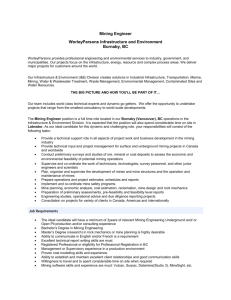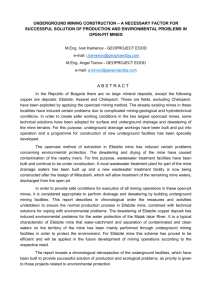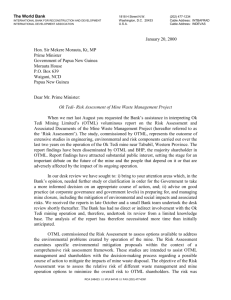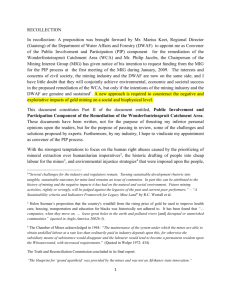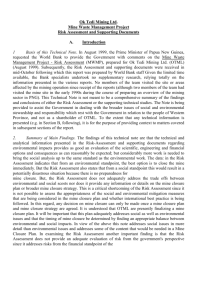compatibility with agreed post mining land use
advertisement
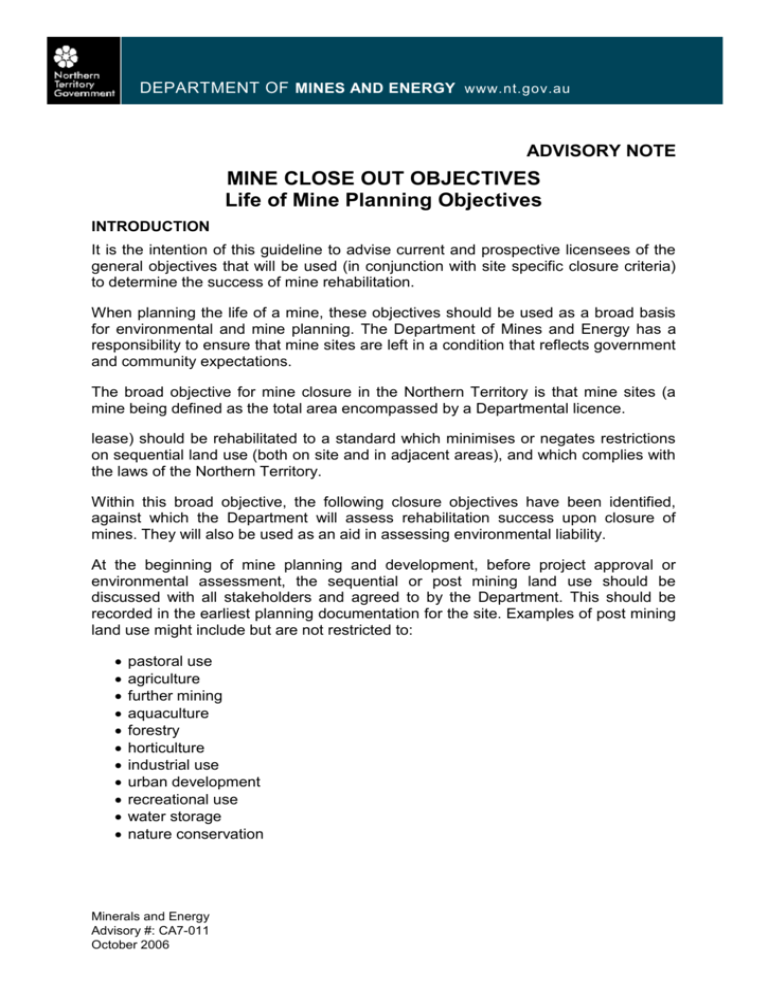
DEPARTMENT OF MINES AND ENERGY www.nt.gov.au ADVISORY NOTE MINE CLOSE OUT OBJECTIVES Life of Mine Planning Objectives INTRODUCTION It is the intention of this guideline to advise current and prospective licensees of the general objectives that will be used (in conjunction with site specific closure criteria) to determine the success of mine rehabilitation. When planning the life of a mine, these objectives should be used as a broad basis for environmental and mine planning. The Department of Mines and Energy has a responsibility to ensure that mine sites are left in a condition that reflects government and community expectations. The broad objective for mine closure in the Northern Territory is that mine sites (a mine being defined as the total area encompassed by a Departmental licence. lease) should be rehabilitated to a standard which minimises or negates restrictions on sequential land use (both on site and in adjacent areas), and which complies with the laws of the Northern Territory. Within this broad objective, the following closure objectives have been identified, against which the Department will assess rehabilitation success upon closure of mines. They will also be used as an aid in assessing environmental liability. At the beginning of mine planning and development, before project approval or environmental assessment, the sequential or post mining land use should be discussed with all stakeholders and agreed to by the Department. This should be recorded in the earliest planning documentation for the site. Examples of post mining land use might include but are not restricted to: pastoral use agriculture further mining aquaculture forestry horticulture industrial use urban development recreational use water storage nature conservation Minerals and Energy Advisory #: CA7-011 October 2006 Minerals and Energy Advisory #: CA7-011 October 2006 Any extra closure criteria specific to the agreed post mining land use or uses should be documented at this early stage. Because mining operations tend to develop in unpredictable ways, planning for rehabilitation needs to be adaptable. During the life of the mine, the post mining land use and the related, specific closure criteria may be reviewed as a result (for example) of changes in adjacent land use, community values, knowledge, commercial opportunities or technical advances. Any changes as a result of these reviews should be discussed by all stakeholders and agreed to by the Department. Any such reviews should occur as part of routine mine/environment planning, and rehabilitation progress should be continually assessed against mine closure criteria. Planning for mine closure and rehabilitation is therefore a process that continues throughout mine life. COMPATIBILITY WITH AGREED POST MINING LAND USE Specific criteria agreed upon for post mining land use at individual sites should be met; Monitoring trends should indicate that the ability of the site to support the post mining land use will be sustained. PHYSICAL SAFETY Excavations and subsidence to be rendered safe; All drill holes, shafts, open cuts and other openings to be securely capped, filled or otherwise made safe; Access of people and livestock to be restricted as appropriate to site conditions. LOW RISK TO BIOTA Protect downstream beneficial use especially with reference to surface and ground water. The quality of water leaving the site should be such as to cause no significant deterioration of water quality to the downstream beneficial use(s) or water quality objectives of the receiving waters declared under Section 73 of the Water Act (1992); Production of polluted water (eg. acidic or caustic runoff from pits, stockpiles, waste rock or tailings) should be minimised, and trends should indicate improvement; Continuing active intervention should not be required for site water management; Page 2 of 4 Minerals and Energy Advisory #: CA7-011 October 2006 Residual toxic material, such as process chemicals, should be removed or contained; mobilisation of toxicants in general should be prevented and, in the case of acid rock drainage, minimised and controlled; All sources of radioactivity should be decontaminated, removed or encapsulated such that levels of radioactivity on site conform to contemporary criteria. STABILITY All disturbed areas should be stabilised, including the construction of stable landforms; Drainage should be consistent with post-mining land use (re-establishment of natural drainage patterns where appropriate); Erosion by wind and water should be at least comparable with background levels for the area; Storages left in situ should be stable (providing an adequate margin of safety which is dependent on material stored) against floods, erosion and subsidence. RUBBISH CLEAN-UP Facilities and equipment should be removed unless they are to remain for an agreed future use; No rubbish should remain at the surface, or at risk of being exposed through erosion. REVEGETATED OR OTHERWISE IMPROVED If natural habitat regeneration is to occur: All surfaces should be revegetated to a self-sustaining condition similar to vegetation in comparable local areas (to a standard consistent with data obtained from pre-mining baseline environmental studies, where these have been done); Vegetation communities should be developed that will attract and support the re-colonisation by native fauna and flora species found in the region; Vegetation should be able to survive the local fire regime; Introduction and spread of weeds and pests particularly those of disease significance should be prevented and an active program in place to minimise their presence. If other post mining land uses are to occur: Site specific revegetation criteria may apply, as agreed during project planning and documented in mine/environment plans. Page 3 of 4 Minerals and Energy Advisory #: CA7-011 October 2006 VISUAL AMENITY Long term visual impact should be minimised by creating acceptable landforms, preferably compatible with adjacent landscape. HERITAGE AND ARCHAEOLOGICAL SITES Condition of heritage and archaeological sites should meet requirements of relevant authorities. For further information or advice on this subject please contact Mining Compliance Department of Mines and Energy GPO Box 4550, Darwin, Northern Territory 0801 Phone : +61 8 8999 6528 Fax : +61 8 8999 6527 E-mail : mineral.info@nt.gov.au Website: www.minerals.nt.gov.au Page 4 of 4





